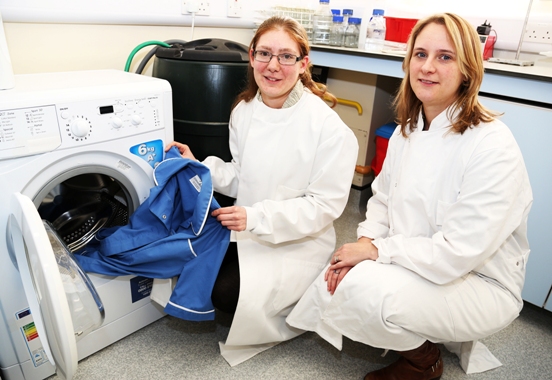De Montfort University Leicester (DMU) researchers have recommended there should be national guidelines set for washing uniforms of nurses and other hospital staff after it was revealed 49 per cent of those surveyed did not use water hot enough at home to kill off certain bacteria.

The ground-breaking research, carried out jointly by DMU microbiologist Katie Laird with PhD student Kate Riley and Principal Lecturer John Williams, from the university’s School of Fashion and Textiles, surveyed 265 hospital staff anonymously at four unnamed hospitals in the East Midlands.
They were asked how often they washed their uniforms, the temperatures they washed them at and whether uniforms were washed separately from other clothing.
The results showed 49 per cent of those surveyed did not wash their uniforms at a recommended temperature of 60°C while 40 per cent also washed their uniforms with other clothing. A total of 74 per cent of respondents said they washed their uniforms after every shift, meaning more than a quarter were potentially carrying bacteria-contaminated clothing into another shift.
The four hospitals surveyed offered different washing guidelines or, in some cases, no guidelines at all on specific aspects of uniform care.
RELATED NEWS
Visit DMU and find out how we help you learn to succeed
DMU's research changes lives
How our campus is being transformed to the tune of £136 million
The report authors have called for national guidelines to be introduced and have also recommended washing of hospital uniforms is moved back in-house.
It is common for staff to launder their uniforms at home as it reduces NHS costs and is more convenient. The report writers have suggested that moving uniform cleaning back in-house would rule out any possibilities of not meeting a national standard.
The research acknowledges the correct cleaning of uniforms is an important aspect of infection control as uniforms can carry Hospital-Acquired Infections (HAIs) such as MRSA and Clostridium difficile.
HAI’s, caught by patients as a result of treatment by healthcare providers, cost the NHS more than £1 billion a year due to prolonged stays in hospitals while the infection is treated. Older people, the young and people with weakened immune systems are particularly vulnerable to these infections which can cause discomfort or pain and in some cases result in disability or even death.
The report says “the development of national guidelines for domestic laundering of healthcare uniforms would ensure greater clarity for staff on how to launder uniforms”.
DMU student Kate Riley, who is studying a PhD in “Textiles - Improving sustainability of regularly laundered healthcare clothing”, was able to carry out the research with the help of a Society for Applied Microbiology Hardship Grant.
She said: “The study highlights the importance of research in this area to determine the overall effectiveness of domestic laundering and deciding whether a return to in-house laundering is the most appropriate solution.”
DMU’s Katie Laird, a national lead in research into the control of hospital-acquired infections and co-author of the report, said: “We would like to thank the hospitals and staff that contributed to this research. Without them we would not have been able to establish what home uniform laundering practices were taking place and thus highlight an important infection control issue.
“This is especially important due to the increase in Hospital Acquired Infections and their antibiotic resistance.”
Ms Riley is currently carrying out research to discover the optimum wash temperatures and wash times to kill off bacteria as well as the best detergents to use. She is also testing the micro-organism survival rate on different textiles to see which materials could be used in uniforms.
She said: “All textiles react differently in a domestic laundering cycle and it is important that suitable fabric choices are made for healthcare uniforms.”
Dr Roger Salmon, Chief Executive of the Textiles Services Association, welcomed the report saying: “The Textile Services Association represents UK laundry and textile rental companies who provide specialist services to the health-care sector.
“It has long been campaigning for a detailed study to support its considered view that through the vehicle of hospital workers wearing both their clean and soiled uniforms in transit, the potential hazard of cross-contamination is increased. The inability of domestic washing machines to carry out a validated hygienic wash process and the practice of mixing classifications at home further exacerbates the cross-contamination potential.
“As with hospital linen and operating theatre garments, nurses’ uniforms should be laundered to a validated hygienic standard to protect patients and staff.”
Posted on Monday 30 March 2015